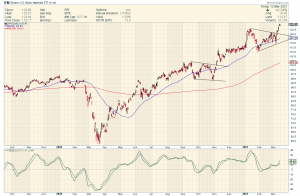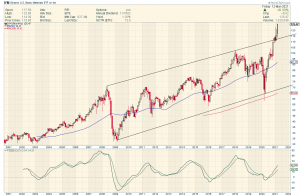BASIC MATERIALS BOOM
This from EddieWoolrich at the Rambus Chartology forum where some really smart investors hang out.
Materials r front running what is to come – A two-megawatt windmill contains 260 tonnes of steel requiring 170 tonnes of coking coal and 300 tonnes of iron ore, all mined, transported and produced by hydrocarbons. The question is: how long must a windmill generate energy before it creates more energy than it took to build it? At a good wind site, the energy payback day could be in three years or less; in a poor location, energy payback may be never. That is, a windmill could spin until it falls apart and never generate as much energy as was invested in building it.
This life-cycle accounting of “energy return on energy invested” (EROEI) succinctly describes multiple stages of intermediate capital within a hydrocarbon-based structure of production. Hughes also hints at the basic questions facing all entrepreneurs—namely, where they should place their investments and how they should configure heterogeneous capital to recoup up-front costs plus some profit or “windfall.”
Wind turbines and solar panels do enjoy a wide market in off-grid applications, such as remote farm properties and on oceangoing sailboats, where the abundance of wind and scarcity of petroleum products makes the investment a no-brainer. In sunny parts of the country, solar has reached “grid parity.” States like Texas, however, have failed to heed considerations of both net energy and supply and demand in installing massive wind farms at great taxpayer expense where fossil fuels would be far cheaper and more reliable. Lacking price signals, the central planner is blind to the economic consequences of his grand designs.
The president revealed his ignorance of the technological and economic problem at hand when he stated matter of factly, “We know what to do, we’ve just got to do it.” On the contrary, we have no idea how to create a nonpolluting electrical grid without emitting much more carbon in the process than we otherwise would have.
If the government invests trillions of dollars in energy-intensive capital investments—whether wind farms, solar charging stations, or transformer stations—it will have two primary effects.
First, it will frontload carbon emissions into the construction phase. This may offer the illusion of reducing pollution when in fact it merely shuffles emissions to a prior stage of production. California’s high-speed rail, for example, will take an estimated seventy-one years to offset its own construction emissions through the cars it will hypothetically replace (assuming it is ever completed). Furthermore, electric charging stations are typically powered by coal or natural gas—not solar panels.
Second, and relatedly, a Green New Deal funded by debt will distort the capital structure, skewing investment toward long-term fixed capital assets at the expense of the intermediate capital maintenance of the overall structure of production. Theoretically we could burn more coal, petroleum, and natural gas today to build a zero-pollution electrical infrastructure for tomorrow. But when it comes time to service offshore wind turbines, will the helicopters and boats used for maintenance be powered by electricity as well? And what kind of energy will power the factories that manufacture the solar panels and wind turbines? Claiming that they will run on renewables is eerily similar to the circular reasoning and magical thinking used by proponents of modern monetary theory to promote the illusion of spending without taxation.
The Green New Deal is, if anything, a formula for a new dark age. Texas’s latest incident is a prime example.
……….
Thanks Sir Eddie. …Basic Materials IS The New GOLD !!!


Thank you, Eddie Woolrich, for this concise dismantling of the case for these monstrosities. Solar power has many similar inconsistencies. We need to get a lot rougher with these virtue signaling fools. In this, and many other areas, they are wholly destructive, all the while prancing around like peacocks, praising themselves and their idiot “solutions”. We either take this fight to them in earnest or we lose the legacy provided by the many generations that came before us.